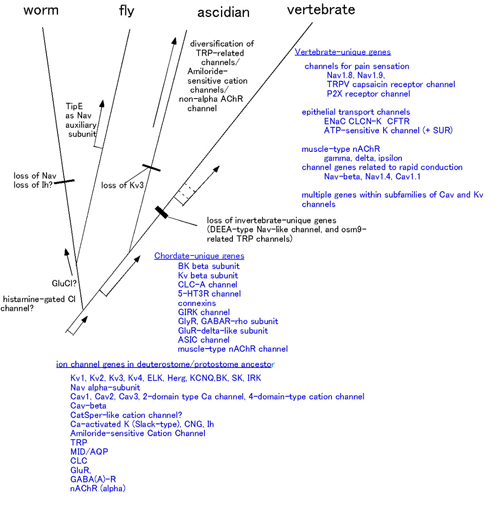Ion fluxes through membrane ion channels play crucial roles both in neuronal signaling and the homeostatic control of body electrolytes. In spite of our knowledge about the respective ion channels, just how diversification of ion channel genes underlies adaptation of animals to the physical environment remains unknown. Here we systematically survey up to 160 putative ion channel genes in the genome of Ciona intestinalis and compare them with corresponding gene sets from the genomes of the nematode Chaenorhabditis elegans, the fruit fly Drosophila melanogaster, and the more closely related genomes of vertebrates. Ciona has a set of so-called "prototype" genes for ion channels regulating neuronal excitability, or for neurotransmitter receptors, suggesting that genes responsible for neuronal signaling in mammals appear to have diversified mainly via gene duplications of the more restricted members of ancestral genomes prior to the ascidian/vertebrate divergence. Most genes responsible for modulation of neuronal excitability and pain sensation are absent from the ascidian genome, suggesting that these genes arose after the divergence of urochordates. In contrast, the divergent genes encoding connexins, TRP-related channels and chloride channels, channels involved rather in homeostatic control, indicate gene duplication events unique to the ascidian lineage. Since several invertebrate-unique channel genes exist in Ciona genome, the crown group of extant vertebrates not only acquired novel channel genes via gene/genome duplications, but also discarded some ancient genes that have persisted in invertebrates. Such genome-wide information of ion channel genes in basal chordates enables us to begin correlating the innovation and remodeling of genes with the adaptation of more recent chordates to their physical environment.
Okamura Y, Nishino A, Murata Y, Nakajo K, Iwasaki H, Ohtsuka Y, Tanaka-Kunishima M, Takahashi N, Hara Y, Yoshida T, Nishida M, Okado H, Watari H, Meinertzhagen IA, Satoh N, Takahashi K, Satou Y, Okada Y, Mori Y. : Comprehensive analysis of the ascidian genome reveals novel insights into the molecular evolution of ion channel genes. Physiol Genomics, 22, 269-282 (2005)

Evolutionary events in ion channel diversification deduced from the comparisons of 160 ion channel genes identified in Ciona intestinalis (asicidan) with those of the nematode (worm), fly, human and fish (vertebrate). Several major events in the appearance and disappearance of channel genes during the radiation from the presumed ancestor are indicated. The differences among these groups are considered to reflect the history on innovations in sensory processing and motor regulation, and also on adaptations to the physical environment in each lineage.